We’re now deep into camping season, which means that our highways and campgrounds are filled with gigantic travel trailers. These campers weigh a shocking number of pounds and often require an even more beefy truck to haul all that heft, but it doesn’t have to be this way. If you can scrape by without bringing your entire house with you on your journey, you can have a ton of fun in a compact trailer – and here’s one I bet you haven’t heard of before. It’s the Carson Kalispell, a mini camper from a brand that makes utility trailers, and its claim to fame is rocketing down a salt flat at 141.998 mph, factory stock except for a pair of high-speed tires.
I just got done camping for a whole week at EAA AirVenture Oshkosh 2025. I got there by hitching up my parents’ roughly 37-foot-long 2022 Heartland Mallard M33 to the back of a 2025 Chevrolet Silverado EV, and I was pleasantly surprised when the truck made the whole trip with charge to spare. But truth be told, this wasn’t really my ideal camping setup. While I do love big trucks and buses, I also adore compact travel trailers. I like the idea of a camper that’s small and light enough to be hauled by whatever crossover is likely in your garage right now. It’s why my dream travel trailer is still the 1,100-pound U-Haul CT13 fiberglass camper. This Kalispell may not be fiberglass, but it slides right into that tiny camper category that I love.
I’ve known about this camper’s existence for years now. MotorTrend first published an article about this camper a whole 13 years ago. Of course, as I alluded to in the lede up there, the Carson Kalispell set the world record for the fastest travel trailer in that same year. What I was shocked by was when Autoevolution recently pointed out that the Kalispell is still in production, and it looks exactly the same as it did in 2012.
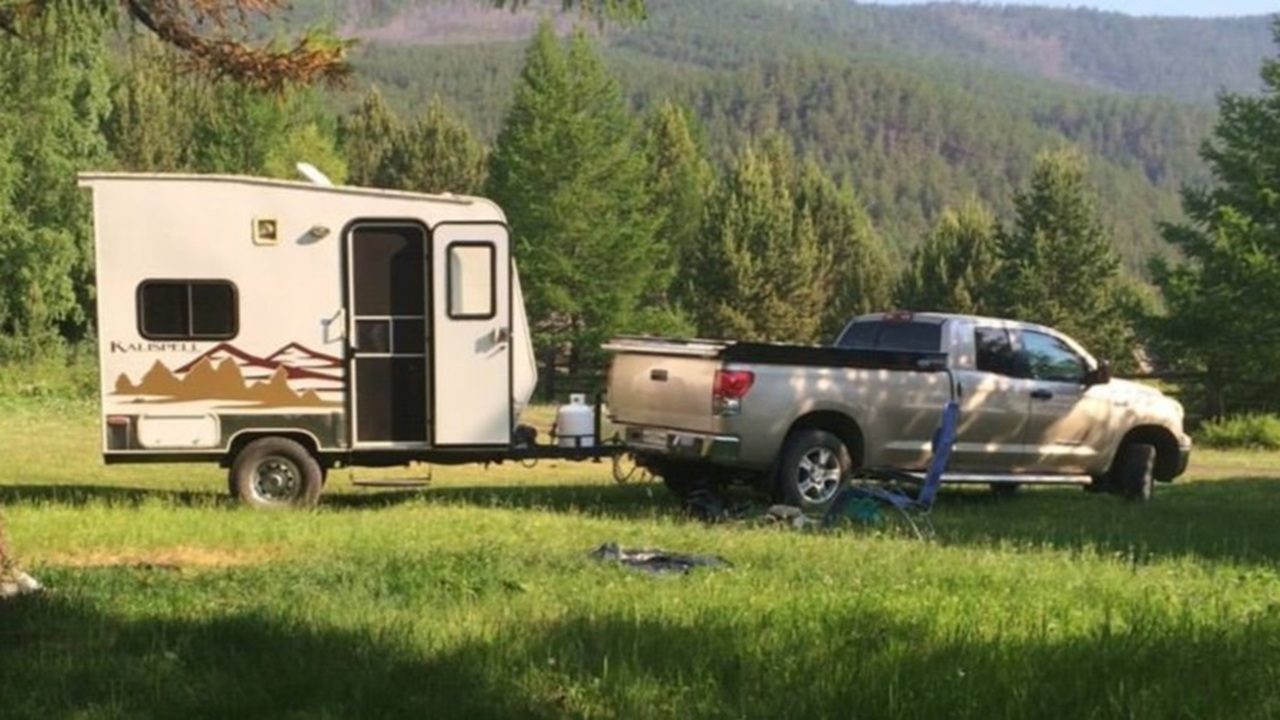
From Equipment Haulers To Campers
The Kalispell isn’t built by a traditional RV manufacturer. From what I’ve been able to find, Carson Trailer, Inc. was founded in California in 1991. Its earliest trailers were sturdy utility trailers, like the ones that you might use to haul a car or landscaping equipment. The company claims to have a handful of manufacturing facilities, and its line of trailers is always growing.
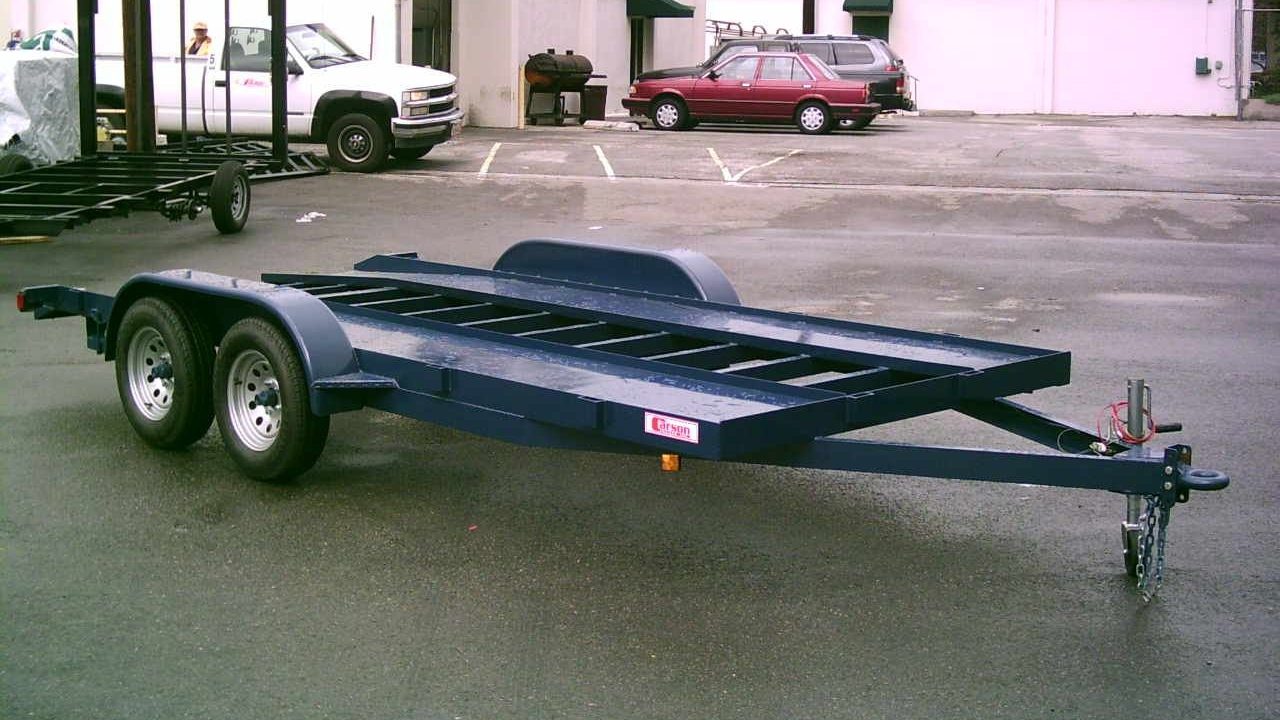
For the vast majority of the Carson Trailer’s history, including in the 1990s, the company’s flagship model was the Fun Runner. Carson claims to be one of the dominating players in the toy hauler niche:
If you’re considering purchasing a toy hauler, look no further than the Carson Fun Runner. Not only have we been building trailers for over 20 years, our Toy Haulers are among the most renown in the U.S. At a time when many of the biggest names in the business have ceased operations, the Carson Toy Hauler Trailer Division has continued to update, innovate and expand, offering more models than ever before. Today we’re considered one of the dominant manufacturers in the niche.
We’re a family run business who personally use the products we build and sell for our own enjoyment. We’ve thrived because we take tremendous pride in our product, our reputation and in being a reliable asset to the trailer industry at large. We’ve never stopped reinvesting in our company as we’re genuinely in it for the long haul. And, we never cut corners. For the exterior siding, Carson always uses .030 mill thickness aluminum siding, compared with the .023 mill thick siding used by most of our competitors. That’s almost 25% thicker! And, don’t forget to compare our metal roof construction against the competition. The majority of trailer manufacturers use rubber roofing to cut corners. Our superior construction is engineered to be long lasting, so you’ll enjoy lower maintenance costs and fewer repairs.
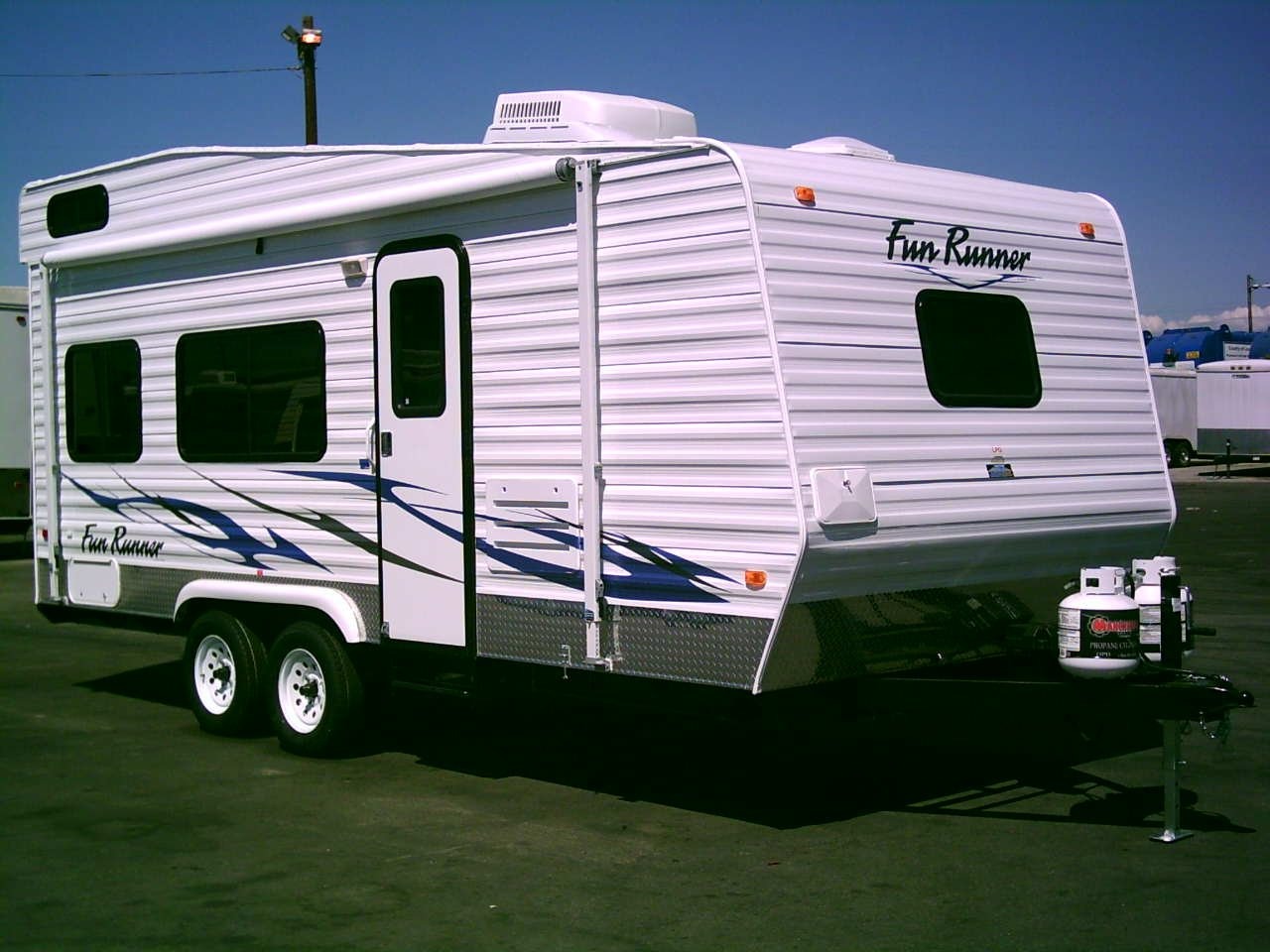
What I find fascinating is Carson’s dedication to sticking with an overall design. While Carson now sells the Fun Runner in several different layouts, the exterior design looks similar to it did in the 1990s. The design has been refined over the years with better materials and other changes says Carson, but the outside is mostly unchanged.
The Kalispell
The little Kalispell didn’t make an appearance on Carson’s website until 2010. The oldest Kalispell models I’ve seen for sale are also from 2010. It’s marketed as a wee sport trailer that’s great for a relaxing weekend in the backcountry.
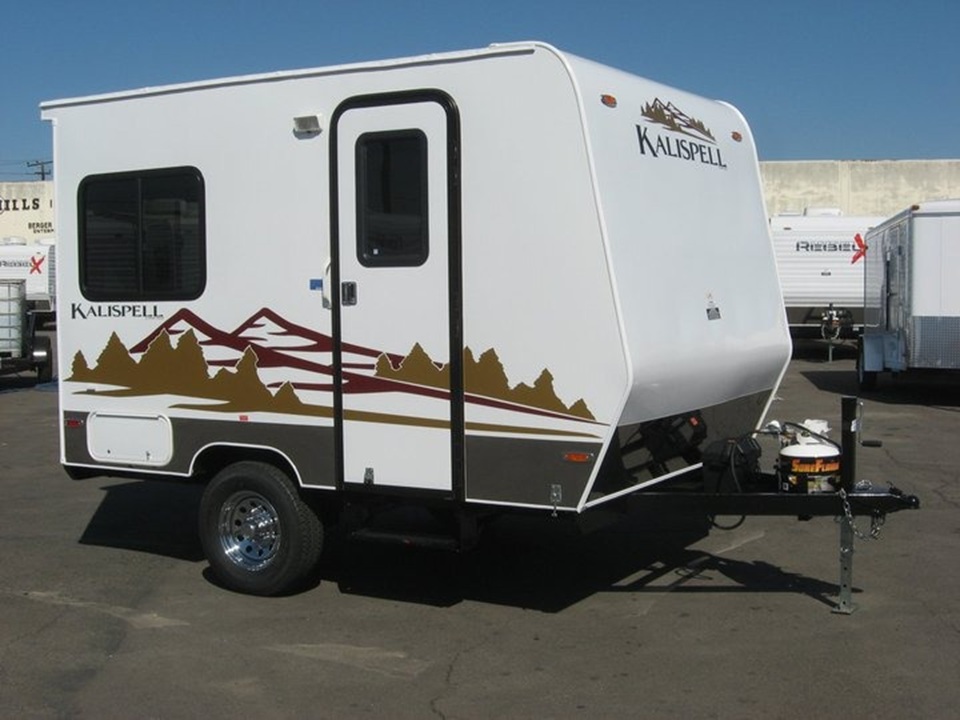
The Kalispell looks like something that could have rolled out of a mega RV factory in Indiana, but Carson says that this thing is built better than one of those rigs. That goes back to the claim above that Carson’s workers use the campers that they build, and the designs reflect their desire to have something that actually works.
The Kalispell features a fully welded, box-section steel frame and a 6,000-pound axle. That alone signals that this camper is different, as campers this size often come with a 3,500-pound axle. If that’s not overkill enough for you, there’s more, as it has a 3,500-pound tongue jack. The tongue doesn’t weigh all that much – it’s only 400 pounds – but Carson wanted to overbuild the trailer so it will last longer.
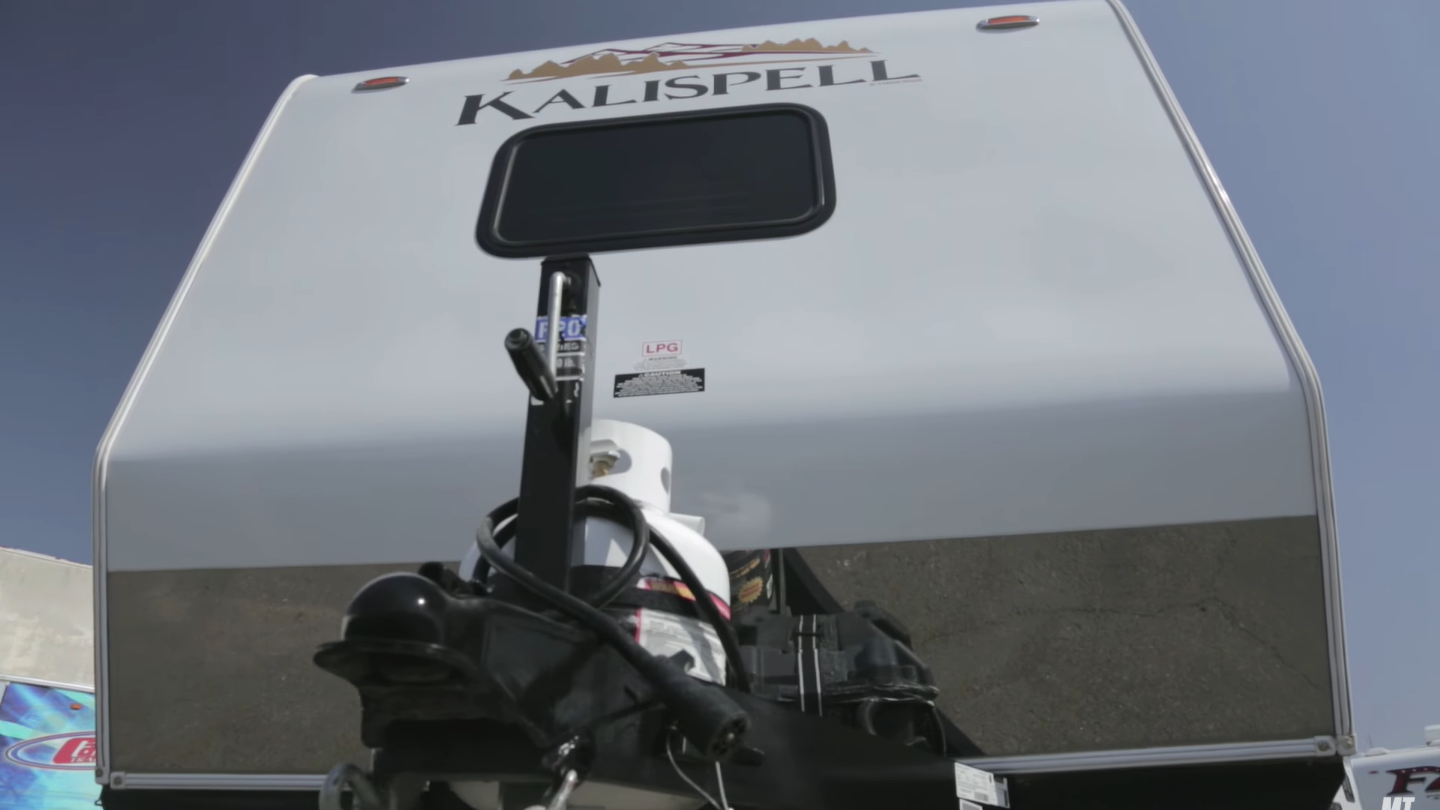
Building for durability continues with the body. We aren’t told what kind of framing is used here, but Carson says it builds its trailers with metal roofs rather than the rubberized roofs typically used, and the aluminum siding is 25 percent thicker than what you’d get in a camper from a big company. Then there are a lot of smaller, less visible changes, including dirt-resistant windows and flooring that doesn’t have a lot of dead space that dust and dirt can hide in.
The way Carson sees it, you should be able to take this thing nearly anywhere you want to camp for years without worrying about crap falling off. Using thick and heavy build materials seems to be why the Kalispell, which has only a 10’6″ box, weighs a whopping 2,670 pounds dry. For comparison, the Coleman 13B that I wrote about earlier this year is three feet longer, yet is 210 pounds lighter.

Also somewhat neat is what you get in the camper. There’s a 40-gallon fresh water tank, a 22-gallon gray tank, and a 22-gallon black tank. The fresh tank is about the size that you’d get in a much larger trailer. For example, my family’s 37-foot Heartland has a 47-gallon tank while the slightly smaller 35-foot Adirondack has a 46-gallon tank.
The interior is relatively loaded for its size, featuring a dinette that turns into a bed, a sink, a two-burner stove, a full-size RV refrigerator, a furnace, a stereo, and a microwave. Options are pretty functional, including an oven and an air-conditioner.
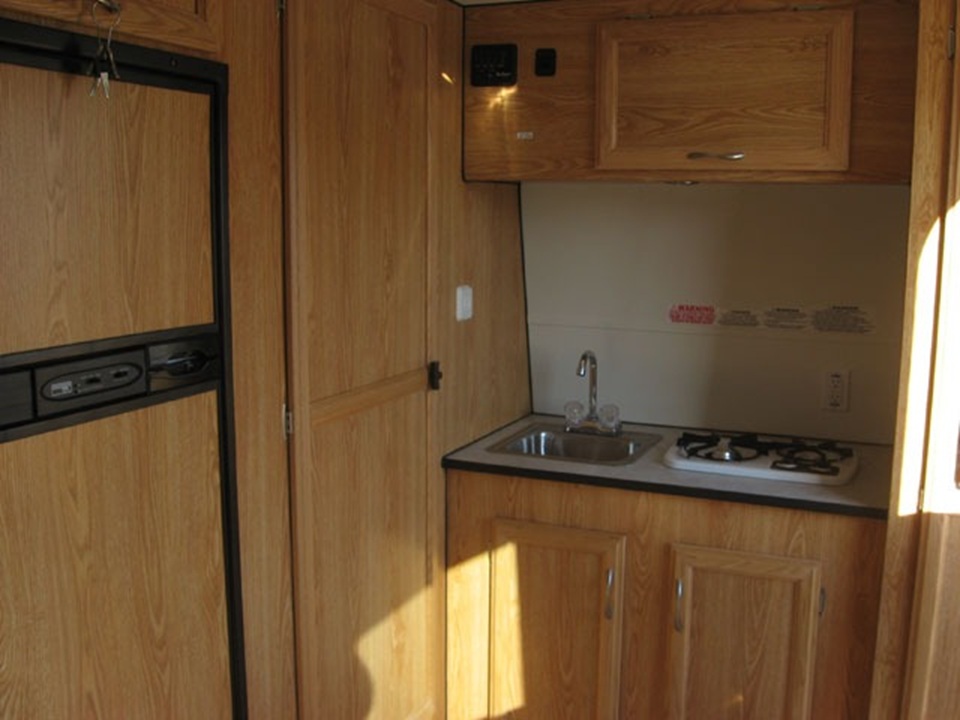
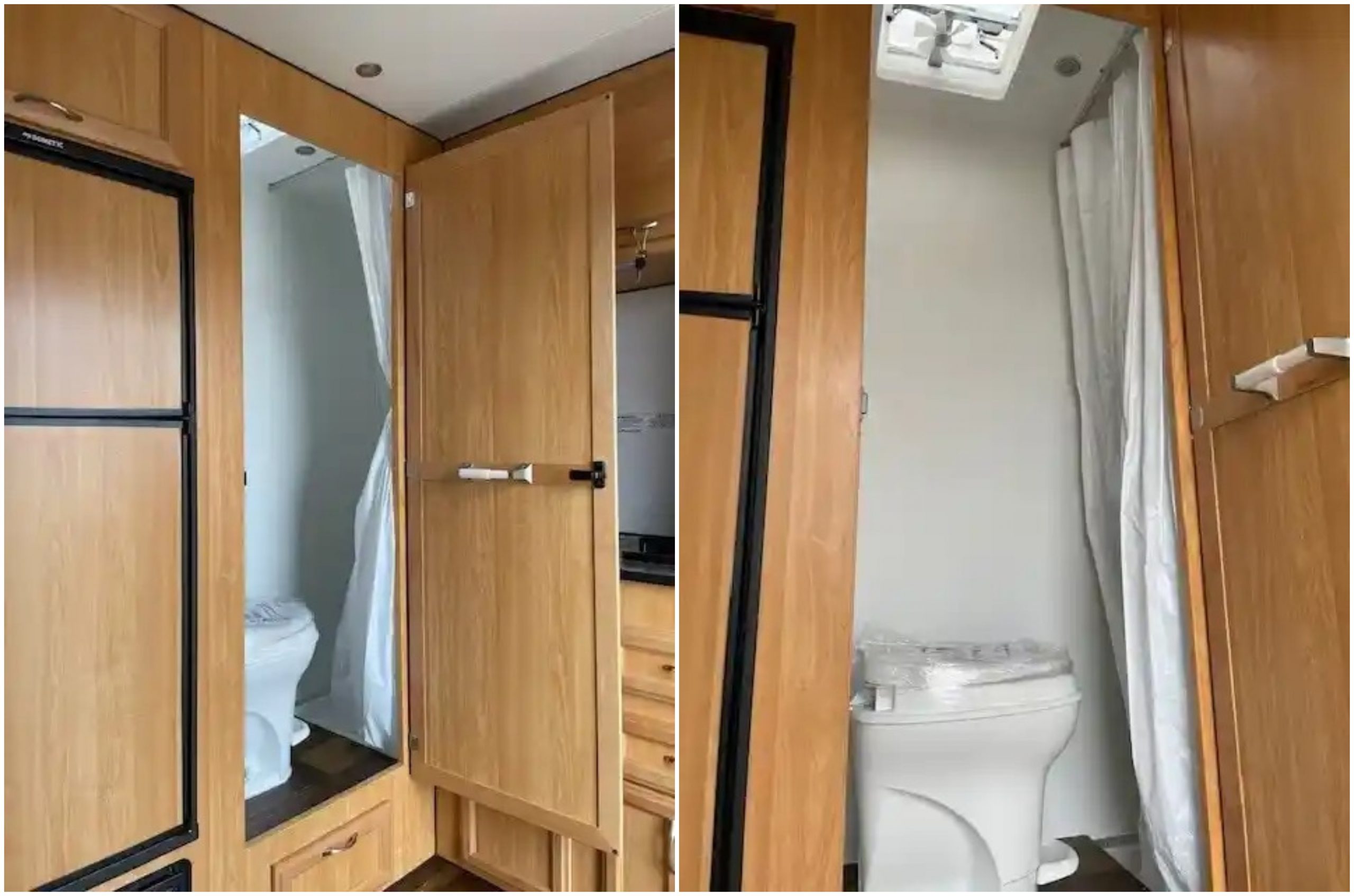
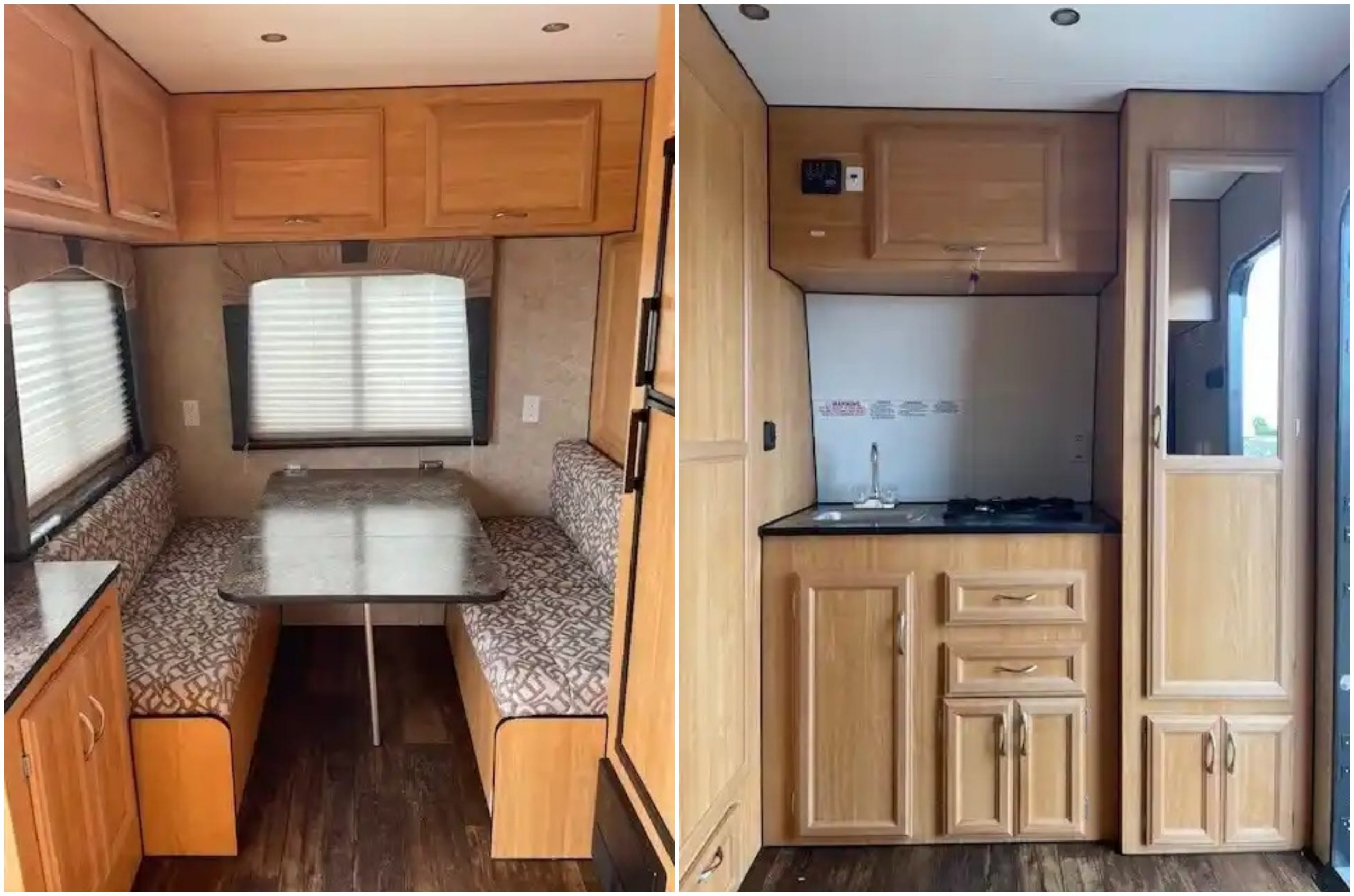
Another highlight is the bathroom. The Carson guys hated using the tiny wet baths that tend to come in small campers, and as a result, gave the Kalispell a wet bath that a big person could use without getting stuck to the walls.
The 10-footer comes with just the dinette that transforms into a bed, but there is a slightly longer 12-foot version of the Kalispell with a little more floor space, a slightly raised roof, and two queen beds stacked on top of each other in the rear.
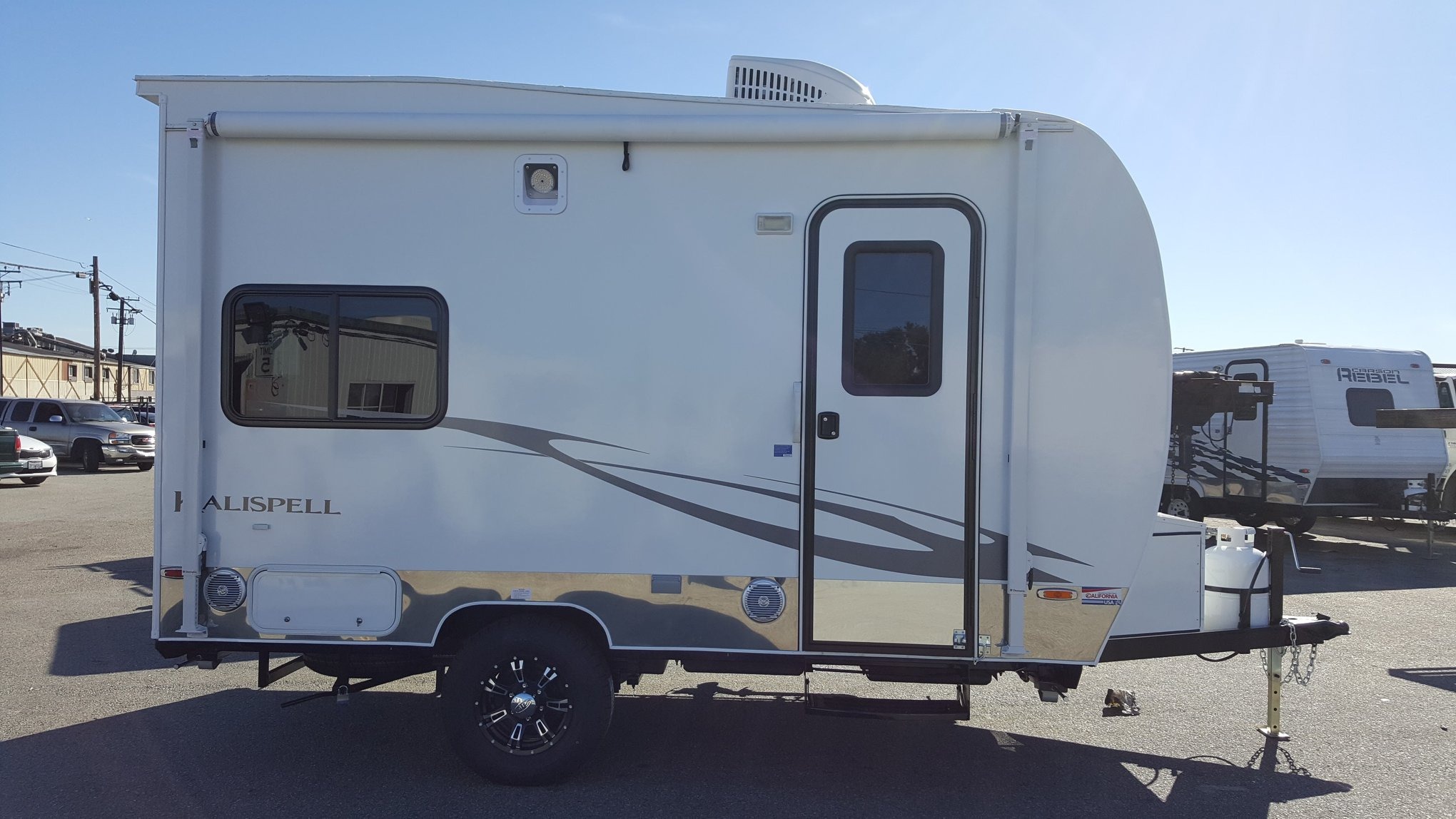
Not everything about the Kalispell is awesome. The trailer has one of those terrible old-school entry steps that always seem to get jammed once they’re old, and you’ll notice that the trailer has no awning and no stabilizer jacks.
Something else that’s interesting is that Carson apparently hasn’t changed the design much since 2010. The 2021 and 2025 models look exactly the same as the 2010 model. I’ve noticed that some of Carson’s dealer ads for new Kalispells even use the original images from 2010. That does give the trailer a bit of a dated look, and likely explains the outdated entry steps and outdated interior. But if it’s built well enough, I wouldn’t care how dated it looks.
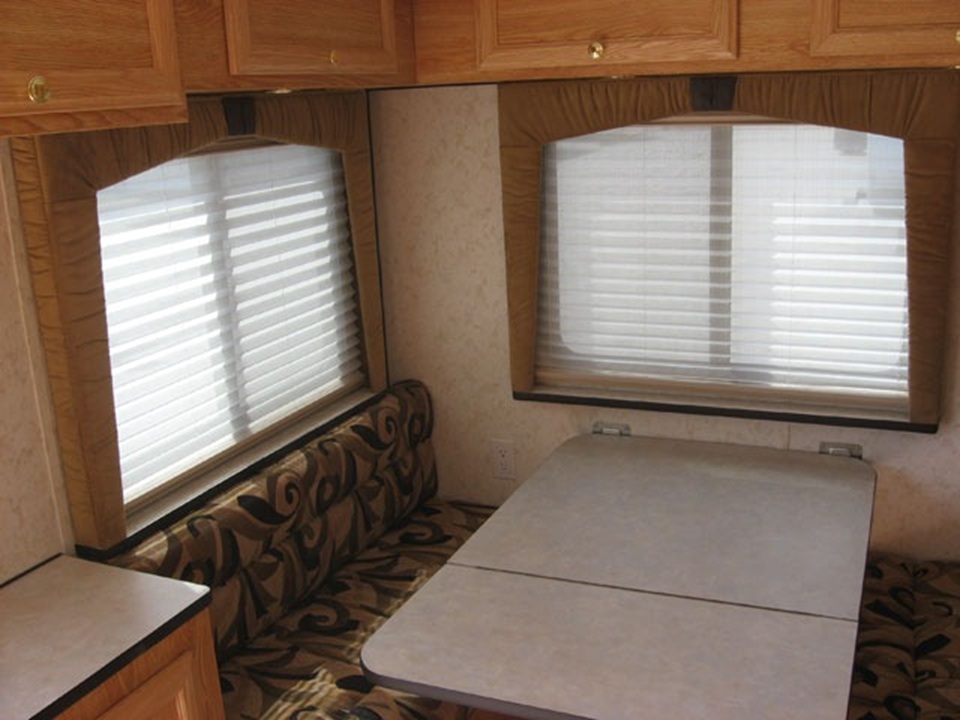
The World’s Fastest Trailer
This camper is obscure in the world of RVs. It comes from a small, family-owned outfit in the west. Carson seems to do even less advertising than Scamp does. Yet, you’ll find a slew of articles about this thing on the Internet, and that’s thanks to Diesel Power Magazine.
In 2012, the magazine’s Associate Editor, Jason Sands, set out to break the Guinness World Record for the fastest trailer tow. The record at the time was 139.11 mph, and Diesel Power wanted to break the record in the craziest possible way. Diesel Power got David Endres, Director of Operations for Carson Trailer, to lend the team a 10-foot Kalispell that was straight off of the factory floor. This trailer was unmodified, save for V-rated tires. Check out the run:
The tow vehicle was a 2006 GMC Sierra 2500HD modified for the job by Pacific Performance Engineering (PPE). Now, trucks are already huge bricks to push through the wind, and adding a trailer only complicates matters. Remember, aero matters more than weight! So the little Kalispell is like a sail in the wind despite its low weight. PPE’s solution was to slather on the power with twin turbos and an intercooler and exhaust system custom-made for the build. The team coaxed over 1,000 HP out of the truck, and that was before a 15-shot of nitrous. The result? The big truck and its little trailer achieved 141.998 mph, a world record that stands today.
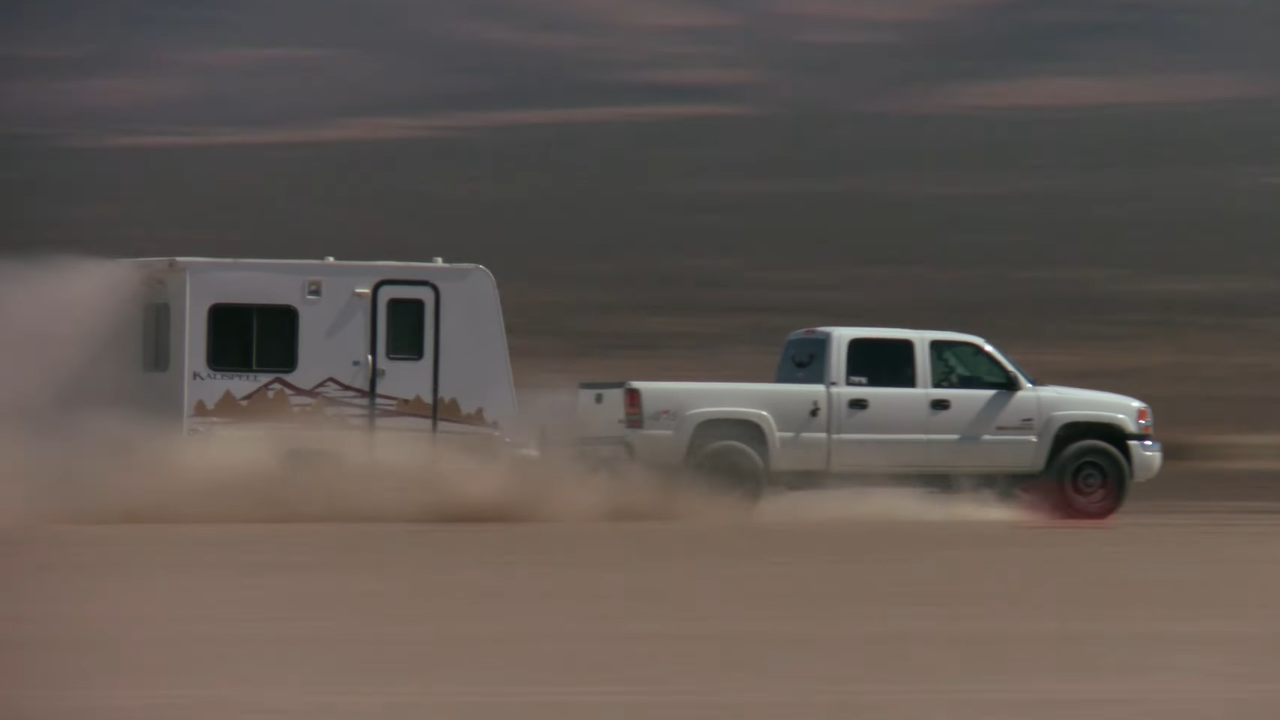
Speed records aside, the Kalispell seems like a pretty decent deal. The original MSRP of these trailers was just $9,999 back in 2012. Today, Carson will sell you one for around $20,000, which isn’t bad at all. Sure, it’s more expensive than something like a Coleman 13B and still more expensive than a 17-foot-long camper, but if it’s built as tough as Carson says it is, the extra dough might be worth it.
Either way, I like a lot of what I see here. It’s awesome to see what happens when people who are passionate about RVing are put in charge of designing campers. The Kalispell is tiny, but it seems to punch above its weight. If you’re crazy enough, it’ll also go wicked fast, too.

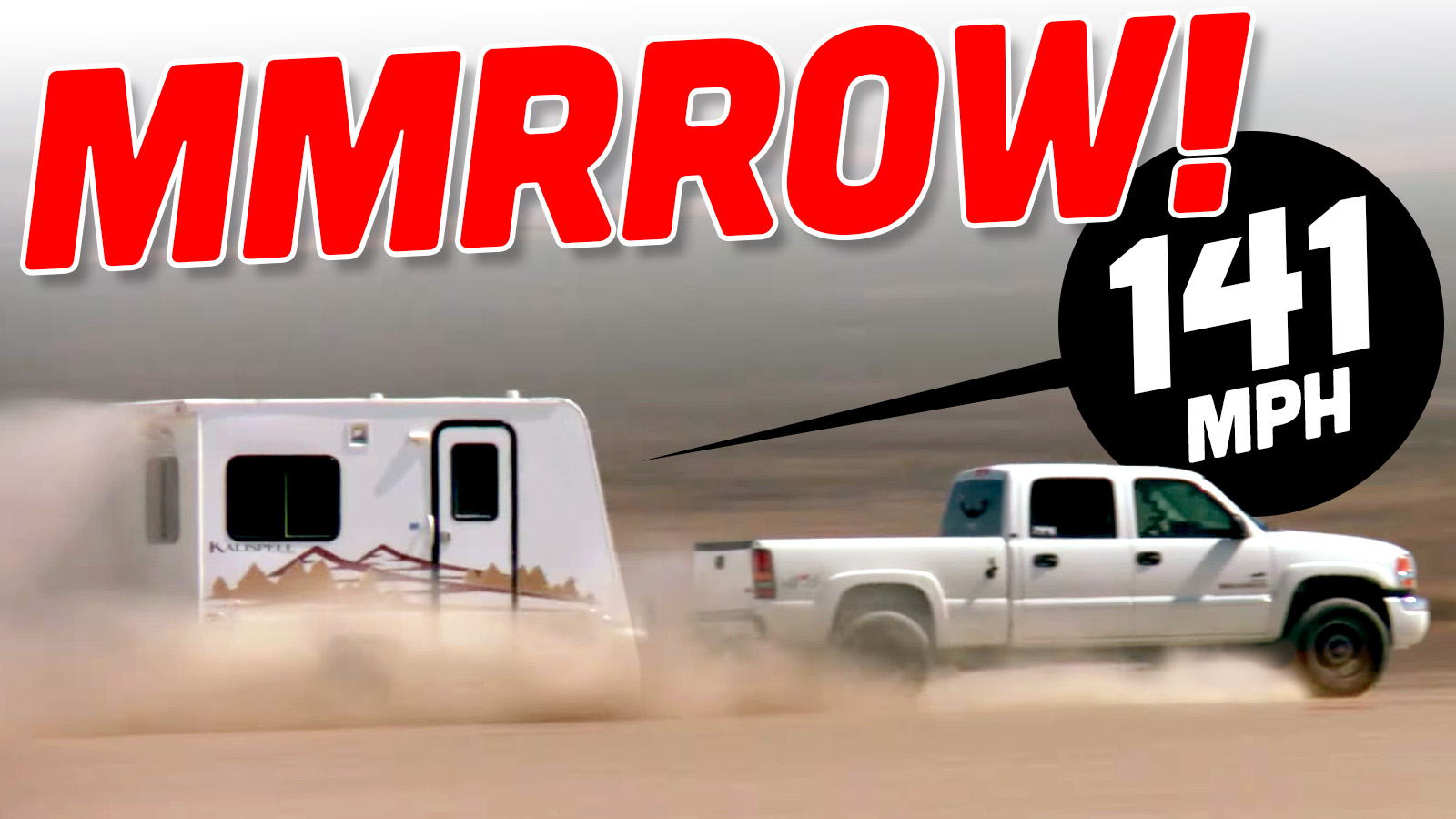







You could have rounded it up to 142 mph and I wouldn’t be mad.
“Not everything about the Kalispell is awesome. The trailer has one of those terrible old-school entry steps that always seem to get jammed once they’re old, and you’ll notice that the trailer has no awning and no stabilizer jacks”
Is that not a rolled up awning in the picture of the Kalispell just above this critique?
I’d say the least awesome thing about this is that God-awful 1970s-tastick interior. Can someone PLEASE send US camper builders some pictures of what the inside of a European camper looks like? Hint, not your grandma’s house that was last remodeled in 1972.
I’m sure here point was that an awning is not standard equipment for the base price, unlike many campers. I am sure they will do anything you want for a price.
Technically speaking, any trailer can be towed at 140+ mph.
And work afterwards?
Once.
Hate to nitpick, but 0.030 mil is 30% thicker than 0.023 mil, not “almost 25% thicker.” It’s 0.007/0.023 since the 0.023 is the comparison case. They’re actually underselling the improvement.
The speed run seems like it should have been conducted by the classic Top Gear crew, with Hammond and Clarkson in the cab of the truck, and James May trapped in the loo in the trailer shouting “Clarksoooon!! Hammooooond!!”
Seems like the rig you want to have. However, I’m waiting for a larger version test driven by the Streeter Family. With ads including all the problems and saying if it can survive the Streeters it can survive anything
I remember reading that article when it came out! Such a wild record
If it’s capable of holding together during this does this mean it is the rare camper built to a standard that it won’t start becoming water soluble in half a decade?
That’s possible. I’m not knowledgeable enough on campers to really know, but my guess is that most buyers do not value that durability enough to make them a sales success. Is there enough marketplace demand at the price they’re charging? Hard to say. Airstream’s survived a long time, but they’re selling a whole premium package that is immediately recognizable. This rig not so much.
Well the Airstream has survived for decades and true RVers know you get an Airstream it lasts. No one is stealing their customers. Someone needs to carve out a niche that airstream doesn’t because everything is coming up Airstream. They got cheap crap market covered there might be another niche.
The kind of person looking to buy the camper that can be towed the fastest probably isn’t the kind of person I’d want to share the road with.
Checked my records your approval is the top of the list among 0% of RV buyers. JK
For people who don’t care about my opinion, they sure get angry when I flip them off for hogging the left lane.
LOBE THE COVER PHOTO OF THA GMT800 CHEBY GOBLESS
Kids, don’t try this at home.
Ugh. As an engineer, so many things on this trailer feel like petting the cat backwards. A professor in one of my classes once said that anyone can make a bridge to last 1000 years and/or handle a 100,000 ton load, but it takes an engineer to build one to last that long or handle that weight using the minimum amount of material. This trailer looks like it was designed by guys that have no idea what they are doing, but figure that making it twice as heavy as it needs to be is a good rule of thumb. Beyond the weight, it looks like the aerodynamics suck as well. I can’t help but wonder what kind of speed they would have achieved with a Bowlus trailer.
The more I look at engineered masterpieces like Bowlus, turds like a standard cost per cubic meter of trailer, and absurdities like this trailer, the more I realize that Airstream trailers may hit the perfect compromise between cost and engineering.
This is my thought, too. I remember making bridges in a class and the person who made the shortest bridge from the materials given had the strongest bridge (of course). This is the same sort of thing. What I like to see are durable, lightweight trailers. We already have a weird arms race with campers taking advantage of ever-increasing towing capacities of pickups instead of getting lighter and designing more aerodynamically.
I am a little bit impressed that they put in those large tanks in such a short trailer, but that’s it.
Throw in that absurdly outdated interior and this one is a total loser for me.
So you want a crappy RV that will fall apart before the interior becomes outdated? What is the thinking here?
The guy who helmed a place I worked years ago was obsessed with the idea of optimization/compactness and very clean style, sorta apple-esque. He also had a tendency to get his way. Actual requirements were high reliability, very low run failure rates, and low cost. What we ended up with was a sleek seemless box that was cheap but fragile, failure prone, and difficult to service. There weren’t adequate resources or runway available to achieve both and he chose… poorly. Amazingly that outfit went bust. The point being whether or not it is poorly designed requires a pretty clear picture of requirements it was intended to meet. Simple and robust to the point of being overbuilt isn’t always the wrong answer.
It’s the old Good, Fast or Cheap, pick two problem. Could they have built it lighter and still met durability requirements, almost certainly, but at what cost? Does that added cost translate to a higher selling price? Does that higher selling price result in fewer sales?
Which brings up the point of the target market. For example the use of the 6000lb axle when using a 3500lb is what many mfgs use. Now to me I’d be willing to spend a reasonable amount more for that 6000lb axle, assuming it also includes larger brakes and higher capacity tires/wheels. Those larger brakes, tires and wheels would make me feel more comfortable coming down a mountain pass or taking it on rough trails.
Thicker siding is another thing that many people may find appealing since they perceive it to be less likely to be damaged than the thinner stuff.
Agreed but marketing people are stupid now. In the old days we would identify the different markets and suggest different models. However marketing scum decided promised we can sell one vehicle to both markets.
IMHO I don’t evaluate RVs like cars, if it is your living quarters it needs evaluated like a house. People here often rate trucks as unneeded because seldom needed. Well any studies done on RVs how much time spent hauling vs time spent sedentary and lived in? I lived in BHC AZ. for a few years. In November thousands of RV people arriving and left the trailer sit until April. Then move out before 100 degrees. Fun fact long time residents removed their boats when the temperature dropped to the 90s. So screw off climate change people saying 100+ degrees is dangerous, but would you prefer good mpg 4 trips a year in a live in RV or a RV That lasts ?
Ever look at Engineering Failure tv program? Never any problems with overbuilt infrastructure 100% of engineers try new or minimum material. That is why Roman aqueducts are still in use today but most new designs don’t last 100 years.
Mercedes said it is 210lbs heavier than a 3′ longer competitor. So call it 300lbs heavier like-for-like? That seems like weight well spent given it is almost certainly FAR more rugged than is typical. Campers are absolute epic heaps of shit as a general rule. They get shaken absolutely to pieces going down the road. If I were going to buy into this nonsense I’d want one built like the Brooklyn Bridge.
American campers seem to hit the “not sweet” spot of being too lightly built to be durable, yet too heavy to be towed by a reasonably-sized vehicle. European campers are far lighter, seem to be no less durable, and can be towed by modest cars. Helped by the fact that Europeans don’t see the need to tow at 90+ down I-75. I was passed by a jacked up pickup towing a huge trailer yesterday while I had the cruise on 85…
You’ve clearly never seen the Top Gear episodes where they complain and joke about people towing RVs going 10-20 KPH below the speed limit….
I have. There is just no reason to tow quickly, ever. But when towing, you should pull over and let people pass rather than obliviously blocking the road.
But in the UK it’s not so much a matter of not being *able* to tow quickly, but more that the roads are so small that you simply can’t go any faster. And as a rule in Europe in general, the speed limit while towing is lower anyway.
I am pretty sure the Euro trailers are even flimsier/leas durable than the crap that comes out of Elkhart. I used to love the Award, an ultra-aerodynamic Euro-style lightweight trailer made in Canada. Until I realized their poor durability, presumably due to their lightweight construction (I recall the build quality actually being very good, they just didn’t last).
But they are light enough to pull with a normal car. I find that a fair tradeoff. Flimsy, appallingly poorly built, and so heavy you need an F-Two-Fiddy to haul them around is ridiculous.
It’s not clearly stated, but I have to assume the Guinness record is specifically for *camping* trailers. Otherwise, throw some v-rated tires on a Harbor Freight 4′ trailer and mount a hitch on a Bugatti or something.
Also, I have to believe the truck had something like 2.56:1 rear gears.
According to the YT it had the stock 3.73 axle and was running 3600 engine rpm in sixth gear (.61 overdrive ratio) through the timing trap. Didn’t mention the tire size.
I see a new Nascar race series in our future.
Perfect opportunity for Camping World to return as the title sponsor of the Truck Series.
470 gallons?
So that’s where that zero came from!
Now we just gotta get Mercedes’ family to put it to the test!